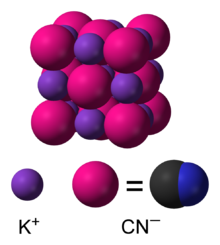
| |

| |
| Names | |
|---|---|
| IUPAC name
Potassium cyanide
| |
| Identifiers | |
3D model (JSmol)
|
|
| ChEBI | |
| ChemSpider | |
| ECHA InfoCard | 100.005.267 |
| EC Number |
|
PubChem CID
|
|
| RTECS number |
|
| UNII | |
| UN number | 1680 |
CompTox Dashboard (EPA)
|
|
| |
| |
| Properties | |
| KCN | |
| Molar mass | 65.12 g/mol |
| Appearance | White crystalline solid deliquescent |
| Odor | faint, bitter almond-like |
| Density | 1.52 g/cm3 |
| Melting point | 634.5 °C (1,174.1 °F; 907.6 K) |
| Boiling point | 1,625 °C (2,957 °F; 1,898 K) |
| 71.6 g/100 ml (25 °C) 100 g/100 ml (100 °C) | |
| Solubility in methanol | 4.91 g/100 ml (20 °C) |
| Solubility in glycerol | soluble |
| Solubility in formamide | 14.6 g/100 ml |
| Solubility in ethanol | 0.57 g/100 ml |
| Solubility in hydroxylamine | 41 g/100 ml |
| Acidity (pKa) | 11.0 |
| −37.0·10−6 cm3/mol | |
Refractive index (nD)
|
1.410 |
| Thermochemistry | |
Std molar
entropy (S⦵298) |
127.8 J K−1 mol−1 |
Std enthalpy of
formation (ΔfH⦵298) |
−131.5 kJ/mol |
| Hazards | |
| GHS labelling: | |
   
| |
| Danger | |
| H290, H300, H310, H330, H370, H372, H410 | |
| P260, P264, P273, P280, P284, P301+P310 | |
| NFPA 704 (fire diamond) | |
| Flash point | Non-flammable |
| Lethal dose or concentration (LD, LC): | |
LD50 (median dose)
|
5 mg/kg (oral, rabbit) 10 mg/kg (oral, rat) 5 mg/kg (oral, rat) 8.5 mg/kg (oral, mouse)[2] |
| NIOSH (US health exposure limits): | |
PEL (Permissible)
|
TWA 5 mg/m3[1] |
REL (Recommended)
|
C 5 mg/m3 (4.7 ppm) [10-minute][1] |
IDLH (Immediate danger)
|
25 mg/m3[1] |
| Safety data sheet (SDS) | ICSC 0671 |
| Related compounds | |
Other anions
|
Potassium cyanate Potassium thiocyanate |
Other cations
|
Sodium cyanide Rubidium cyanide lithium cyanide caesium cyanide |
Related compounds
|
Hydrogen cyanide |
Except where otherwise noted, data are given for materials in their standard state (at 25 °C [77 °F], 100 kPa).
| |
Potassium cyanide is a compound with the formula KCN. It is a colorless salt, similar in appearance to sugar, that is highly soluble in water. Most KCN is used in gold mining, organic synthesis, and electroplating. Smaller applications include jewellery for chemical gilding and buffing.[4] Potassium cyanide is highly toxic, and a dose of 200 to 300 milligrams will kill nearly any human.
The moist solid emits small amounts of hydrogen cyanide due to hydrolysis (reaction with water). Hydrogen cyanide is often described as having an odor resembling that of bitter almonds.[5][6]
The taste of potassium cyanide has been described as acrid and bitter, with a burning sensation[7][unreliable source?] similar to lye.[8]
- ^ a b c NIOSH Pocket Guide to Chemical Hazards. "#0522". National Institute for Occupational Safety and Health (NIOSH).
- ^ "Cyanides (as CN)". Immediately Dangerous to Life or Health Concentrations (IDLH). National Institute for Occupational Safety and Health (NIOSH).
- ^ "Potassium Cyanide | Cameo Chemicals | NOAA".
- ^ Andreas Rubo, Raf Kellens, Jay Reddy, Joshua Wooten, Wolfgang Hasenpusch "Alkali Metal Cyanides" in Ullmann's Encyclopedia of Industrial Chemistry 2006 Wiley-VCH, Weinheim, Germany. doi:10.1002/14356007.i01_i01
- ^ "Suicide note reveals taste of cyanide". 8 July 2006.
- ^ Not everyone, however, can smell cyanide; the ability to do so is a genetic trait.Online Mendelian Inheritance in Man (OMIM): 304300
- ^ ലേഖകൻ, മാധ്യമം (19 December 2021). "'സയനൈഡ് ചവർപ്പാണ്... പുകച്ചിലാണ്...'; ആ 'രുചി രഹസ്യം' പുറത്തുവിട്ട മലയാളി നടന്ന വഴിയിലൂടെ | Madhyamam". www.madhyamam.com (in Malayalam). Retrieved 21 December 2021.
- ^ "The only taste: Cyanide is acrid". hindustantimes.com. Hindustan Times. 8 July 2006.
